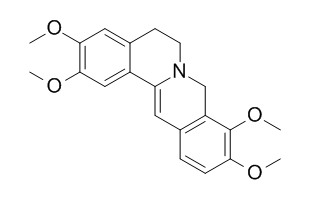Dihydropalmatine
Reference standards.
Inquire / Order:
manager@chemfaces.com
Technical Inquiries:
service@chemfaces.com
Tel:
+86-27-84237783
Fax:
+86-27-84254680
Address:
1 Building, No. 83, CheCheng Rd., Wuhan Economic and Technological Development Zone, Wuhan, Hubei 430056, PRC
Providing storage is as stated on the product vial and the vial is kept tightly sealed, the product can be stored for up to
24 months(2-8C).
Wherever possible, you should prepare and use solutions on the same day. However, if you need to make up stock solutions in advance, we recommend that you store the solution as aliquots in tightly sealed vials at -20C. Generally, these will be useable for up to two weeks. Before use, and prior to opening the vial we recommend that you allow your product to equilibrate to room temperature for at least 1 hour.
Need more advice on solubility, usage and handling? Please email to: service@chemfaces.com
The packaging of the product may have turned upside down during transportation, resulting in the natural compounds adhering to the neck or cap of the vial. take the vial out of its packaging and gently shake to let the compounds fall to the bottom of the vial. for liquid products, centrifuge at 200-500 RPM to gather the liquid at the bottom of the vial. try to avoid loss or contamination during handling.
J Ginseng Res.2023, 47(4):593-603.
J Cachexia Sarcopenia Muscle.2022, 13(6):3149-3162.
The Journal of Animal & Plant Sciences.2020, 30(6):1366-1373
Food Funct.2022, 13(14):7638-7649.
Molecules2021, 26(1),230
American Association for Anatomy2020, doi: 10.1002.
Appl. Sci.2021, 11(24),12080
BioResources J.2020, 15(3).
TCI CO.2019, US20190151281A1
Phytochemistry2018, 15:83-92
Related and Featured Products
Food Addit Contam Part A Chem Anal Control Expo Risk Assess. 2015;32(6):799-807.
Rapid screening for the adulterants of Berberis aristata using direct analysis in real-time mass spectrometry and principal component analysis for discrimination.[Pubmed:
25739096]
Adulteration or substitution of commercial Berberis aristata and its herbal products with inferior-quality substituents is very common.
METHODS AND RESULTS:
Metabolic profiling of B. aristata, along with its common adulterants/contaminants/substituents such as B. asiatica, Mahonia borealis and Coscinium fenestratum, was rapidly carried out using direct analysis in real-time mass spectrometry (DART MS) to generate the chemical fingerprints for the differentiation of these species. Phytochemical analysis showed the presence of mainly alkaloids. The identified alkaloids were berberrubine, berberine, jatrorrhizine, ketoberberine, palmatine, Dihydropalmatine or 7,8-dihydro-8-hydroxyberberine, berbamine and pakistanamine. Berberine, which was mainly reported from the root and stem bark of B. aristata, was also identified in the leaf along with chlorogenic acid. The DART MS data have been subjected to principal component analysis (PCA). The resulting score plots showed clustering and clear differentiation of the species and plant parts.
CONCLUSIONS:
It is thus apparent that the technique of DART MS followed by PCA is a quick and reliable method for the direct profiling of B. aristata and its adulterant plants and plant parts. The study reports the rapid analytical method to identify the possibility of illegal adulteration/contamination/substitution in potential plant materials and herbal extracts.



